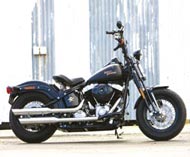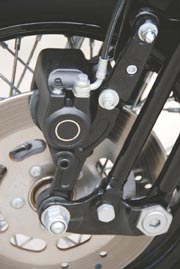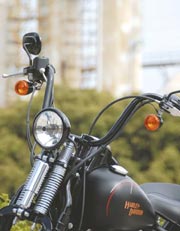
Bad to the bones
Bare … err … bones bobber
Wait long enough, they say, and everything comes back into fashion but while it might be best to leave that black velvet cat-suit you wore in the ’70s undisturbed in the attic as other cycles of fashion can yield worthwhile results. For example, the bobber: the pared-down, essentials-only style of custom long overlooked in favour of its flashier sibling, the chopper, is now enjoying its own revival.
It’s all in the technology.
 Hardtails (motorcycle rear ends without any springing or damping) and girder front ends (the precursors of today’s telescopic forks) were de rigueur for bobbers before and immediately after World War II. Hardtails and girders didn’t work very well, but there was little alternative.
Hardtails (motorcycle rear ends without any springing or damping) and girder front ends (the precursors of today’s telescopic forks) were de rigueur for bobbers before and immediately after World War II. Hardtails and girders didn’t work very well, but there was little alternative.
Sprung saddles took the worst of the road shocks, but not very effectively — not least because they didn’t have any damping worth mentioning.
Today, a bike like Harley-Davidson’s Cross Bones can look every inch the bobber but still function like a … well, a functioning motorcycle. Hardtail? Check (though there are springs and shock absorbers hidden under what H-D calls a softail frame). Girder forks? Check (though these Springers work a treat). Sprung seat? Check (but mainly for looks). Fat front tyre, another bobber must-have? Check (made less annoying by modern compound and construction).
The bike looks, simply, bad to the bone. Apart from a little carefully chosen chrome, it is black; gloss or flat, but black. The narrow lines of the decorative paint are very much like lipstick on the proverbial mastiff — intriguing, but not convincing in their attempt to soften the look. Styling is spot on, from the almost discreet skull and crossbones (with head of design Willie G Davidson’s signature) that graces the oil tank to the periscope headlight. The Springer front end has never looked better and even the oil lines look as if they’ve been hand-sculpted.
Two balancer shafts allow the engine to be bolted straight to the frame — a visual must — which makes it all the more disappointing that the front blinker mounts are of plain, untreated metal. The blinker mounts had a light coat of corrosion when I rode the near-new bike and stuck out like … well, like something really obvious. Why, Harley-Davidson? All it would take is a little chrome or a lick of black paint.
 While I’m in a critical mood — and it’s hard to stay critical of such a successful design exercise — the single-disc front brake is about as useful as the narrow drum was on the original 1940s WLA. True, big cruisers rely on the rear brake far more than sports bikes do but the front stopper is still the more important. This one is ugly, too.
While I’m in a critical mood — and it’s hard to stay critical of such a successful design exercise — the single-disc front brake is about as useful as the narrow drum was on the original 1940s WLA. True, big cruisers rely on the rear brake far more than sports bikes do but the front stopper is still the more important. This one is ugly, too.
It takes quite a bit of effort just to move the handlebars and push the bike around. There is no getting around the fact that it’s heavy, although that isn’t a problem once you’re using the engine rather than muscle power. It would be easy to get carried away by the improvement the Cross Bones offers over the original bobbers, but the suspension quickly reminds you that Softail and Springer are not among H-D’s most successful solutions. Poor road surfaces of any kind quickly take the, err, spring out of the bike’s step.
Engine output, on the other hand, might be relatively mild but is a lot of fun, especially since it comes on just right to punch the bike away from a stop then let you cruise happily.
Quickspecs
Model: Harley-Davidson FLSTSB Cross Bones
Price: $29,250 plus on-road charges
Warranty: Two years, unlimited distance
Power: 54kW @ 5300rpm
Torque: 120Nm @ 3300rpm
Engine: Air-cooled, 45-degree, vee-twin, OHV with two valves per cylinder, fuel-injection and digital ignition
Bore x stroke: 93.5 x 111.1mm
Displacement: 1584cc
Compression: 9.2:1
Transmission: Six-speed, wet multi-plate clutch, final-drive by belt
Suspension: Front, Springer fork, travel 97 mm. Rear, twin shocks, preload adjustable, 109mm travel
Dimensions: Seat height 676mm, kerb weight 333kg, fuel capacity 18.9 litres, wheelbase 1630mm
Tyres: Front, MT 90 E16. Rear, 200/55 R17
Frame: Twin-cradle steel tubing
Brakes: Front, 292mm discs with single-piston floating calliper; rear, 292mm disc with twin-piston floating calliper
Top speed: Who cares?
Acceleration:
0-100km/h: Yeah
60-100km/h: Yeah, sure
Fuel consumption: 5.8 litres per 100km, unleaded
Theoretical range: 325km
Colours: Vivid Black; Black Denim; Pewter Denim; Dark Blue Pearl — but you’d only have it in black, surely.
Verdict: Winning style
